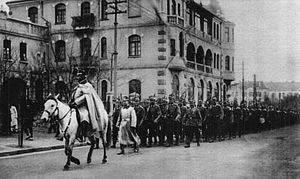A hundred years ago this month, a Pacific empire began to crumble.
In the final quarter of the 19th century, the German Empire began to acquire Pacific territories. Chief among the German possessions was the naval base at Tsingtao (Qingdao), where the Kaiserliche Marine would station a squadron of relatively modern warships, built around the armored cruisers Scharnhorst and Gneisenau. Germany also acquired a sprinkling of islands across the Pacific, bringing it into tension with both Japan and the United States.
The U.S. acquisition of the Philippines came, at least in part, out of concern that Germany would either acquire the archipelago from Spain or would take advantage of the newly independent Commonwealth to secure its position. The main threat to the German Empire in the Pacific would come from Japan, however. Tokyo realized after the first few weeks of fighting that Germany could not hope to hold onto her Pacific territories, no matter the outcome of the war in Europe.
Admiral Maximilian von Spee realized that the Far East Squadron could not survive against either the Imperial Japanese Navy or the Royal Australian Navy, which had recently been stiffened by the arrival of the battlecruiser HMAS Australia. The crack German force nevertheless caused enormous trouble for Britain and her allies. The main body of Spee’s squadron set out across the Pacific, while he detached the light cruiser Emden to terrorize British shipping in the Indian Ocean. Spee tied down British and Australian ships across the Pacific, and at the Battle of Coronel destroyed a squadron of British cruisers in the Royal Navy’s worst defeat in a century. Spee’s journey would end at the Battle of Falklands, where a pair of Royal Navy battlecruisers completely destroyed the German force.
The war permanently ended Germany’s imperial position in East Asia. Had the German Army’s offensive into France in August 1914 worked as expected, Berlin might have been able to force a settlement on Paris and London that could have forestalled the Japanese declaration of war, and even perhaps picked up a few of the French Pacific islands. However, this likely would only have set the stage for a long-term confrontation between Germany and Japan in the Pacific. Japan’s imperial designs preceded the First World War, and Tokyo would likely have continued to see Germany’s possessions as an easy mark. Still, such an outcome might have produce some interesting triangular diplomacy between Tokyo, Berlin, and Washington.
In any case, the expedition (and the empire) left an enduring imprint on maritime affairs and East Asian geography. Scharnhorst and Gneisenau gave their names to a famous pair of World War II German battleships, and Maximilian Graf von Spee gave his name to a heavy cruiser (which, ironically, would be lost off the coast of South America only a month into World War II). The success of the mission at occupying the attention of much larger Allied forces gave grist for the German raiding strategy of the early years of World War II. Japan assumed control of German-owned Caroline Islands, building a formidable naval base at Truk.
Nor was the legacy entirely military. The famous Tsingtao brewery was founded during the period of German colonization, and passed to Japanese and British ownership after Japanese forces seized the base. It was eventually nationalized by the Chinese communist government, was privatized during the 1990s, and is now partially owned by American and Japanese beer conglomerates.
































